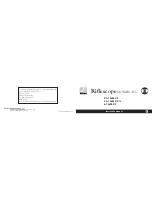
3
table of contents
1. Parts List. . . . . . . . . . . . . . . . . . . . . . . . . . . . . 3
2. Assembly . . . . . . . . . . . . . . . . . . . . . . . . . . . . 3
3. Using Your Telescope . . . . . . . . . . . . . . . . . . . 5
4. Setting Up and Using the Equatorial Mount . . 7
5. Collimation (Aligning the Mirrors) . . . . . . . . . 11
6. Astronomical Observing . . . . . . . . . . . . . . . . 13
7. Astrophotography . . . . . . . . . . . . . . . . . . . . . 16
8. Care and Maintenance . . . . . . . . . . . . . . . . . 17
9. Specifications . . . . . . . . . . . . . . . . . . . . . . . . 18
1. Parts list
1 Optical tube assembly
1 German type equatorial mount
1 Counterweight shaft
1 Large counterweight
1 Small counterweight
3 Tripod legs with accessory tray bracket attached
3 Leg attachment screws with wingnuts and washers
3 Leg lock knobs
1 Accessory tray with mounting hardware
2 Slow-motion control cables
1 Polar axis finder scope
1 Plastic cover for polar axis finder scope
2 Optical tube mounting rings (one with piggyback mount)
1 6x30 achromatic crosshair finder scope
1 Finder scope bracket with O-ring
1 25mm Sirius Plössl eyepiece
1 10mm Sirius Plössl eyepiece
1 Dust cap
1 Collimation cap
4 Assembly tools (2 wrenches, Phillips screwdriver, flat-head
screwdriver key)
2. assembly
After opening the box your telescope came in, make sure all
the parts listed in part 1 are present and familiarize yourself
with their features. Please keep the original shipping box and
interior packaging! In the unlikely event that you should need
to ship the original telescope back to Orion for warranty repair
service, you must use the original packaging.
Assembling the telescope for the first time should take about
30 minutes. No tools are needed other than the ones provid-
ed. All bolts should be tightened securely to eliminate flexing
and wobbling, but be careful not to over-tighten or the threads
may strip. Refer to Figure 1 during the assembly process.
During assembly (and anytime, for that matter), DO NOT
touch the surfaces of the telescope mirrors, the lenses of the
finder scope or eyepieces with your fingers. The optical sur-
faces have delicate coatings on them that can easily be dam-
aged if touched inappropriately.
1.
Lay the equatorial mount on its side. Attach the tripod legs
one at a time to the mount using the leg attachment screws.
Line up the holes in the top of the leg with the holes in the
base of the mount, and insert the screw so it passes through
the leg and the mount. Tighten the wingnuts only finger-tight,
for now. The washers go between the screw’s head and the
leg, and between the wingnut and the leg.
2.
Insert and tighten the leg lock knobs into the base of the tri-
pod legs. For now, keep the legs at their shortest (fully retract-
ed) length; you can extend them to a more desirable length
later, after the scope is completely assembled.
3.
With the tripod legs now attached to the equatorial mount,
stand the tripod upright (be careful!) and spread the legs apart
as far as they will go, until the accessory tray bracket is taut.
4.
Attach the accessory tray to the bracket with the three
wingnut-head screws already installed in the tray. Push the
screws up through the holes in the bracket, then thread them
into the holes in the tray.
Welcome to the exciting world of amateur astronomy! Your new AstroView 6 EQ Reflector is designed for
high-resolution viewing of astronomical objects. With its precision optics and equatorial mount, you’ll be
able to locate and enjoy hundreds of fascinating celestial denizens, including the planets, Moon, and a
variety of deep-sky galaxies, nebulas, and star clusters.
These instructions will help you set up, properly use, and care for your telescope. Please read them thor-
oughly before getting started.
Warning:
Never look directly at the Sun
through your telescope or its finder scope—even
for an instant—without a professionally made
solar filter that completely covers the front of
the instrument, or permanent eye damage could
result. Young children should use this telescope
only with adult supervision.






























